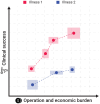Investigation toward the economic feasibility of personalized medicine for healthcare service providers: the case of bladder cancer
- PMID: 38808135
- PMCID: PMC11130437
- DOI: 10.3389/fmed.2024.1388685
Investigation toward the economic feasibility of personalized medicine for healthcare service providers: the case of bladder cancer
Abstract
In today's complex healthcare landscape, the pursuit of delivering optimal patient care while navigating intricate economic dynamics poses a significant challenge for healthcare service providers (HSPs). In this already complex dynamic, the emergence of clinically promising personalized medicine-based treatment aims to revolutionize medicine. While personalized medicine holds tremendous potential for enhancing therapeutic outcomes, its integration within resource-constrained HSPs presents formidable challenges. In this study, we investigate the economic feasibility of implementing personalized medicine. The central objective is to strike a balance between catering to individual patient needs and making economically viable decisions. Unlike conventional binary approaches to personalized treatment, we propose a more nuanced perspective by treating personalization as a spectrum. This approach allows for greater flexibility in decision-making and resource allocation. To this end, we propose a mathematical framework to investigate our proposal, focusing on Bladder Cancer (BC) as a case study. Our results show that while it is feasible to introduce personalized medicine, a highly efficient but highly expensive one would be short-lived relative to its less effective but cheaper alternative as the latter can be provided to a larger cohort of patients, optimizing the HSP's objective better.
Keywords: healthcare economics; healthcare systems management; patient-centric care; personalized medicine; resource-constrained healthcare.
Copyright © 2024 Savchenko and Bunimovich-Mendrazitsky.
Conflict of interest statement
The authors declare that the research was conducted in the absence of any commercial or financial relationships that could be construed as a potential conflict of interest.
Figures




Similar articles
-
A qualitative systematic review of internal and external influences on shared decision-making in all health care settings.JBI Libr Syst Rev. 2012;10(58):4633-4646. doi: 10.11124/jbisrir-2012-432. JBI Libr Syst Rev. 2012. PMID: 27820528
-
The future of Cochrane Neonatal.Early Hum Dev. 2020 Nov;150:105191. doi: 10.1016/j.earlhumdev.2020.105191. Epub 2020 Sep 12. Early Hum Dev. 2020. PMID: 33036834
-
A Service-oriented Framework for Developing Personalized Patient Care Plans for COVID-19.Proc Int Conf Digit Gov Res. 2021 Jun;2021:234-241. doi: 10.1145/3463677.3463742. Epub 2021 Jun 9. Proc Int Conf Digit Gov Res. 2021. PMID: 35224568 Free PMC article.
-
Nursing Personnel in the Era of Personalized Healthcare in Clinical Practice.J Pers Med. 2020 Jun 29;10(3):56. doi: 10.3390/jpm10030056. J Pers Med. 2020. PMID: 32610469 Free PMC article. Review.
-
Advances in the Management of Diabetes Mellitus: A Focus on Personalized Medicine.Cureus. 2023 Aug 18;15(8):e43697. doi: 10.7759/cureus.43697. eCollection 2023 Aug. Cureus. 2023. PMID: 37724233 Free PMC article. Review.
Cited by
-
Integrating Analytical Procedures in Routine Practices of Centralized Antiblastic Compounding Units for Valorization of Residual Compounded Drugs.Pharmaceutics. 2025 Jan 14;17(1):101. doi: 10.3390/pharmaceutics17010101. Pharmaceutics. 2025. PMID: 39861749 Free PMC article.
-
Identifying and Forecasting Importation and Asymptomatic Spreaders of Multi-drug Resistant Organisms in Hospital Settings.medRxiv [Preprint]. 2025 Feb 19:2024.07.14.24310393. doi: 10.1101/2024.07.14.24310393. medRxiv. 2025. Update in: NPJ Digit Med. 2025 Mar 7;8(1):147. doi: 10.1038/s41746-025-01529-x. PMID: 39072020 Free PMC article. Updated. Preprint.
-
Prognostic value of neutrophil-to-lymphocyte ratio in patients with non-muscle-invasive bladder cancer with intravesical Bacillus Calmette-Guérin immunotherapy: a systematic review and meta-analysis.Front Immunol. 2024 Oct 23;15:1464635. doi: 10.3389/fimmu.2024.1464635. eCollection 2024. Front Immunol. 2024. PMID: 39507536 Free PMC article.
-
Circadian Rhythm Disruption in Cancer Survivors: From Oncogenesis to Quality of Life.Cancer Med. 2024 Oct;13(20):e70353. doi: 10.1002/cam4.70353. Cancer Med. 2024. PMID: 39463009 Free PMC article. Review.
-
Identifying and forecasting importation and asymptomatic spreaders of multi-drug resistant organisms in hospital settings.NPJ Digit Med. 2025 Mar 7;8(1):147. doi: 10.1038/s41746-025-01529-x. NPJ Digit Med. 2025. PMID: 40055525 Free PMC article.
References
-
- Reder MW. Some problems in the economics of hospitals. Am Econ Rev. (1965) 55:472–80.
LinkOut - more resources
Full Text Sources

